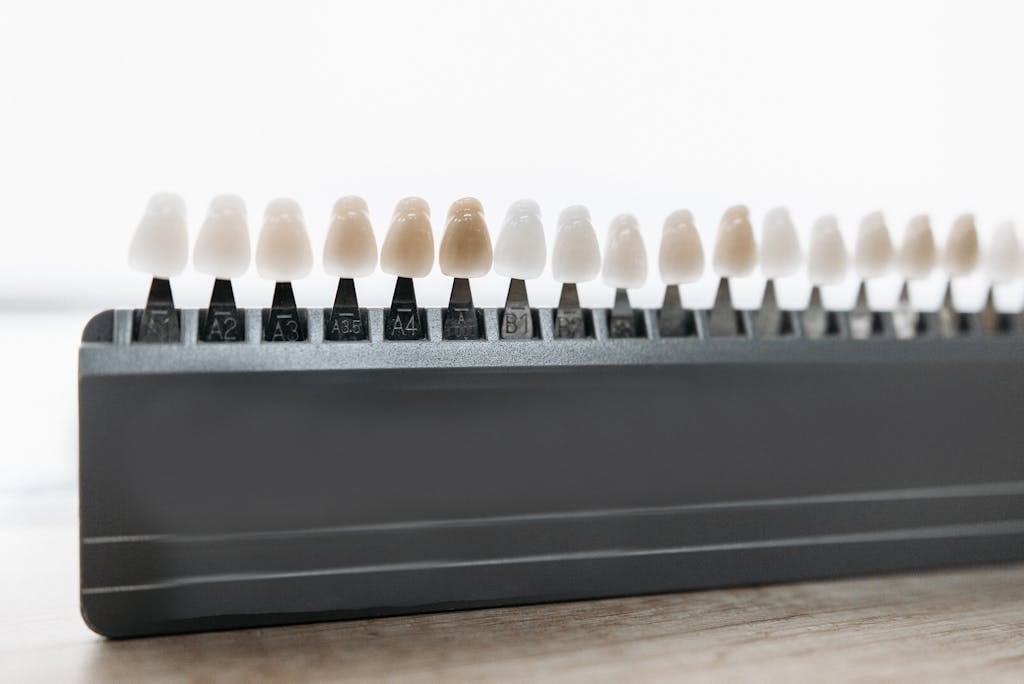FREE SHIPPING OVER $50
Teeth Bonding vs Veneers: What’s the Difference?
Teeth bonding and veneers are two types of cosmetic dentistry solutions that can enhance your smile. They can both improve the appearance and function of your teeth. However, while these two treatments may seem similar, there are some major differences between them. To help you figure out which dental restoration method is right for you, here is a glimpse at the difference between teeth bonding and veneers, how they work, and when each method should be used.
| Aspect | Teeth Bonding | Veneers |
|---|---|---|
| Application | Applied directly to your tooth; single visit | Bonded to front tooth surface; may require multiple visits |
| Permanence | May need replacement after years | Durable; may last a lifetime |
| Aesthetic Properties | Can match tooth color; less translucent | More natural appearance; translucent like natural teeth |
| Procedure Complexity | Simple; single visit; minimal tooth preparation | Complex; multiple visits; tooth surface preparation and custom creation of veneers |
| Suitability | Minor cosmetic changes; temporary corrections; low bite pressure areas | Severe tooth discoloration, malformation, or malposition; major smile changes; long-term aesthetic improvements |

What Is Teeth Bonding?
Teeth bonding involves applying a tooth-colored composite resin to one or more of your teeth to repair damage. It’s a cost-effective solution because it’s considerably less expensive than other cosmetic dental procedures, such as veneers and crowns. Teeth bonding can be done in a single visit unless several teeth are involved. It’s used to repair teeth that are decayed, chipped, fractured, discolored, or to reduce gaps between teeth.
Types of Teeth Bonding
- Direct Composite Dental Bonding: This involves using tooth-colored composites to fill cavities, repair chips or cracks, close gaps between your teeth, and build up the worn-down edges of teeth. The procedure is minimally invasive and can be completed in a single dental visit.
- Direct Composite Veneer Bonding: This procedure also involves the application of composite resin material directly to your teeth. However, the focus is on improving the appearance of the teeth.
- Indirect Dental Bonding (Inlays): Indirect dental bonding, also known as inlays, are tooth fillings made in a single piece outside the mouth and fitted or bonded into the tooth cavity. They are made of solid substances such as gold, porcelain, or composite resin.
What Are Dental Veneers?
Dental veneers are custom-made, thin shells of tooth-colored materials designed to cover the front surface of teeth to improve their appearance. These shells are bonded to the front of the teeth, changing their color, shape, size, or length. Dental veneers can be made from porcelain, acrylic or resin composite materials. Porcelain veneers resist stains better than resin veneers and better mimic the light-reflecting properties of natural teeth.
Types of Veneers
- Porcelain Veneers: These are made from fine, stain-resistant dental porcelain. They are custom-designed and usually about one millimeter thick.
- Composite Veneers: These are made from a tooth-colored resin. They are less expensive and faster to install than porcelain veneers but have a shorter lifespan.
- Lumineers: These are a specific brand of porcelain veneers that are much thinner than standard veneers and less durable.
- Removable Veneers: Also known as snap-on veneers, these are custom-made, removable prosthetics that fit perfectly over your teeth.
- Palatal Veneers: These custom-built appliances are used to restore anterior teeth that have been damaged by dental erosion or other similar problems.
- Temporary Veneers: These are thin shells, typically made from composite materials or acrylic, that serve as a temporary covering for your natural teeth.
Teeth Bonding vs Veneers: How Are They Similar?
Both teeth bonding and veneers are dental treatments that improve the appearance and function of teeth. They are typically used to restore teeth that are somehow damaged, whether discolored, crooked, decayed, chipped, cracked, or broken.
Teeth bonding and veneers are both made to match the color of the rest of your teeth to give you a seamless, complete smile. Once they are applied, it’s difficult to tell the difference between teeth bonding and veneers because they will each have a similar effect on your smile.
You will care for both teeth bonding and veneers virtually the same way. You’ll need to brush them twice daily just like your teeth and floss to remove food particles. Regular dentist visits will also be needed for professional cleaning and to check the restorations.
Teeth Bonding vs Veneers: How Are They Different?
One of the key differences between teeth bonding and veneers is the material used. Porcelain veneers are known for their durability and resistance to staining, making them a popular choice for those seeking long-lasting solutions.
On the other hand, while teeth bonding is a quicker and more affordable procedure, it may not last as long as veneers. The composite resin used in teeth bonding may need to be replaced after a certain number of years.
Aesthetic Differences
In terms of aesthetics, veneers often provide a more natural and translucent appearance, closely mimicking the properties of natural teeth. Teeth bonding, while able to match the color of your teeth, may not have the same level of translucency, which could make them appear less natural in certain light conditions.
Procedure and Recovery
The procedures for teeth bonding and veneers also differ. Teeth bonding is a relatively simple process that can often be completed in a single visit without the need for any tooth preparation. Veneers, on the other hand, require a more complex procedure, including the preparation of the tooth surface and the creation of a custom veneer in a dental laboratory. This means that getting veneers usually involves at least two visits to the dentist.
Suitability
Teeth bonding is typically suitable for minor cosmetic changes, temporary correction of cosmetic defects, and for correction of teeth in areas of low bite pressure (for example, front teeth). Veneers, being more robust, can be suitable for severe cases of tooth discoloration, malformation, or malposition. They can also be a good choice for patients seeking a major change in the appearance of their smile
How Much Does Teeth Bonding and Veneers Cost?
The cost of teeth bonding vs veneers can vary greatly. Teeth bonding is considerably less expensive than veneers. The cost of teeth bonding can range from $100 to $1000 per tooth, while porcelain veneers can typically cost anywhere between $925 and $2,500 per tooth. Dental insurance will often cover part of the cost of teeth bonding if it’s done for structural reasons or to fill a cavity. However, it will not usually cover the cost of veneers since they are considered cosmetic.
| Procedure | Type | Estimated Cost Range |
|---|---|---|
| Teeth Bonding | Direct Composite Dental Bonding | $300-$600 per tooth |
| Teeth Bonding | Direct Composite Veneer Bonding | $250-$1,500 per tooth |
| Teeth Bonding | Indirect Dental Bonding (Inlays) | $650-$1,200 per tooth |
| Veneers | Porcelain Veneers | $500-$2,500 per tooth |
| Veneers | Composite Resin Veneers | $250-$1,500 per tooth |
| Veneers | Lumineers | $700-$2,000 per tooth |
| Veneers | Removable Veneers | $300-$3,500 per arch |
| Veneers | Temporary Veneers (Trial Veneers) | $200-$400 per arch |
| Veneers | Palatal Veneers | $600-$1,200 per tooth |
Please note that these are estimated costs and the actual cost can vary depending on various factors such as your location, the extent of the procedure, and the dentist’s expertise.
Is Teeth Bonding or a Veneer Right for Me?
Since teeth bonding and veneers seem to provide basically the same function, they can be used interchangeably, right? Actually, no. Your dentist will recommend one dental treatment option over the other based on your specific situation. But the following should be noted
Teeth Bonding
Teeth bonding is typically recommended for minor cosmetic corrections, such as:
- Repairing a chipped or cracked tooth
- Closing small gaps
- Improving the appearance of a discolored tooth
It’s a simpler and more cost-effective procedure that can often be completed in a single visit.
Veneers
On the other hand, veneers are usually used for more extensive cosmetic changes, such as:
- Changing the shape or size of your teeth
- Covering severe discoloration that can’t be corrected with teeth whitening
The process of getting veneers is more complex and may require multiple visits.
Related Articles
If you enjoyed this blog post you can explore more health insurance reviews for your friends and family like:
- The 10 Best Hydroxyapatite Toothpaste Brands for Stronger Teeth!
- Top 10 Best Dental Implant Insurance
- Types of Dental Crowns and Cost: What You Need to Know Before
- Top 10 Best Dental Insurance in Florida
- United Dental Insurance Review
- Spirit Dental Insurance: A Comprehensive Review
- Anthem Dental Insurance Review
- Humana Dental Insurance Review
Sources:
- Consumer Guide to Dentistry: Dental Bonding | Cost of Adhesive & Direct Composite Bonding
- NewMouth: 5 Types of Veneers – Procedure, Cost




“Hello there! I recently noticed that you’ve taken the time to visit my website, and I wanted to express my heartfelt gratitude for your interest. Your support means a lot to me. In return, I would like to extend my support by visiting your website as well.